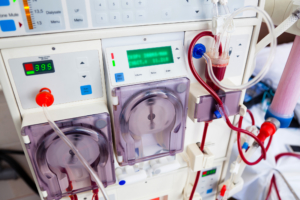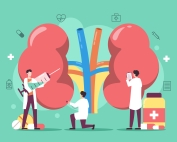Hemodialysis

In the United States hemodialysis is the most common treatment for people with end-stage renal disease (ESRD), also known as kidney failure.
Hemodialysis is a treatment that uses a machine to act as an artificial kidney, removing the fluids and wastes that your kidneys cannot. Tubes transfer small amounts of your blood to the machine to be cleaned and then moved back to your body.
You can undergo this treatment in a clinic (in-center hemodialysis) or at your home (home hemodialysis). Treatment options vary not only by location, but also frequency, length and time of day.
Hemodialysis Access
In order for the blood to be cleaned, there must be a way to get it from the body to the machine. There are three ways that the blood can be “accessed”: Arteriovenous (AV) fistula, AV graft, and catheter. The fistula is often considered the gold standard because it has fewer problems and usually lasts much longer that the other options. Care must be taken to prevent infection with any type of dialysis access.
The access is connected to the HD machine using two needles. A small amount of the patient’s blood at a time flows through one needle to the hemodialysis machine through special tubing. In the machine the blood goes through the dialyzer (filter) where waste products and extra fluids are removed. The blood then goes back into the body through the second needle, and the cycle continues for the length of the treatment.
AV fistula is made during outpatient surgery by connecting an artery to a vein to increase blood flow. This causes the vein to get larger and stronger, so that the dialysis needles can be used for every treatment. The fistula is usually placed in the lower arm, but can also be in the upper arm or thigh. Fistulas are the “gold standard” of hemodialysis access because they have much less chance of clotting and infection, and they typically last longer than other types of access. A fistula needs to “mature” for 2-3 months before it can be used for dialysis.
AV graft, a synthetic or artificial tube is used to connect an artery and vein under the skin. Grafts are normally used when veins are too small or fragile to make into fistula. Problems can include clotting and infection, and the graft may need to be replaced if the problems cannot be fixed. A graft can be used for treatment 2-3 weeks after placement.
A catheter is a tube normally inserted through the skin near the collar bone and connected to the large vein from the heart. A catheter is sometimes needed when dialysis first starts, while a fistula is maturing, or if there are no other access options. These are normally for short term or temporary access only because of problems such as infection, clotting and poor dialysis treatments. A catheter can be used right away.
To learn more about hemodialysis access, go to the National Kidney and Urologic Diseases Information Clearing House at https://www.niddk.nih.gov/health-information/kidney-disease/kidney-failure/hemodialysis.


































